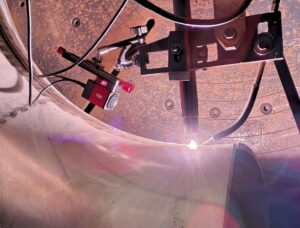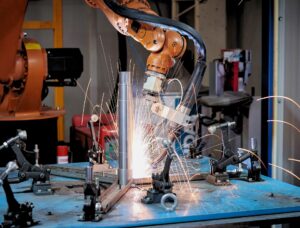Choosing the right camera for monitoring, inspection, and automation
Industrial welding environments are harsh, high-temperature, and often hard to access—making real-time visibility both essential and difficult. That’s where the weld monitoring system comes in. Whether used for quality control, operator training, or automation, a welding camera is only as good as the features it offers. In this blog, we’ll explore the top features to look for in an industrial welding camera and how to choose the right system for monitoring, inspection, and automation applications.
1. Advanced Arc Filtering
The welding arc emits intense light that can saturate standard camera sensors. Look for cameras equipped with:
- High Dynamic Range (HDR) imaging
- Optical filters (IR/UV suppression)
- Auto-exposure or auto-dimming technology
These features ensure clear visuals of the weld pool and surrounding metal—even during high-amperage arcs.
2. High Resolution and Frame Rate
Clarity is critical when you’re looking for tiny weld defects or monitoring fast welds.
- Minimum 1080p (Full HD) resolution
- Frame rates of 60fps or higher for smooth video
- High-speed recording for detailed playback during inspections or troubleshooting
High-resolution video allows better process control and supports machine learning for automated systems.
3. Rugged and Heat-Resistant Housing
Welding environments aren’t camera-friendly. Choose systems that offer:
- Protective enclosures that resist heat, sparks, and dust
- Compact, lightweight designs for easy mounting in tight spaces
- Cooling mechanisms (like water or air cooling) for continuous operation in high-temperature zones
Durability is especially important in shipbuilding, heavy fabrication, and pipeline welding.
4. Real-Time Streaming and Recording
Live monitoring helps spot defects as they occur. Your camera should be capable of:
- Low-latency real-time video transmission
- Integration with remote monitors or control rooms
- Built-in or cloud-enabled recording for weld quality documentation and training
This is a must-have feature for critical welds in nuclear, aerospace, or oil and gas sectors.
5. Compatibility with Welding Automation Systems
For robotic or automated welding lines, the camera should integrate with:
- Robotics controllers (e.g., via Ethernet or industrial protocols)
- Weld-tracking software
- Machine learning platforms for defect detection and adaptive control
Cameras that feed into these systems can help enable autonomous weld adjustments and improve throughput without sacrificing quality. Companies can scale up documentation without increasing overhead, especially for large projects with hundreds of welds.
6. Wide Dynamic Range (WDR)
Welding scenes often contain both extremely bright and dark areas. WDR technology allows the camera to:
- Capture details in both highlights (the arc) and shadows (surrounding metal)
- Avoid image washout or underexposure
- Provide more usable data for review and AI processing
7. Flexible Mounting and Field of View Options
Whether you’re mounting on a welding arm or inside a tight chamber, versatility matters.
- Adjustable lenses or zoom functions
- Wide-angle or telephoto lens compatibility
- Mounting accessories for pipes, frames, or robotic arms
This ensures you get the exact angle needed to monitor the weld effectively.
8. Software and User Interface
The camera’s interface and software ecosystem can make or break usability. Look for:
- Intuitive dashboards for monitoring and playback
- Customizable overlays (arc position, timestamp, weld ID)
- Easy integration with existing systems
Some cameras also come with built-in AI or analytics features to flag defects automatically.
9. Remote Access and Control
For hazardous or hard-to-reach weld sites, remote camera operation is a game-changer.
- Remote zoom, focus, and pan/tilt
- Live monitoring from control rooms or mobile devices
- Remote diagnostics and software updates
This is especially valuable in nuclear, offshore, or underwater welding environments.
10. Proven Industry Use
Lastly, go with a camera system that’s field-tested in your industry. Whether it’s aerospace, oil and gas, structural steel, or shipbuilding, the best welding cameras will have real-world performance data and references to back up their claims.
Final Thoughts: Top Features to Look for in an Industrial Welding Camera
Investing in a high-quality welding camera is not just about getting a clearer picture—it’s about improving weld quality, minimizing downtime, ensuring operator safety, and enabling smarter automation.
By choosing a welding camera with the right features, you’re setting your team up for greater productivity and long-term reliability.
Need help selecting the right welding camera for your application?
Mecaweld offers camera systems tailored for heavy industry, robotic welding, and critical applications. Let us know your specs—we’re here to help. Contact us now.



